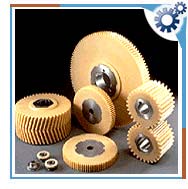 Internal gears have cylindrical pith surface with teeth parallel to the
axis. Gears make an internal contact with these gears. They have the
teeth cut on the inside of the rim rather than the outside. When they
are used with the pinion more teeth carry the load and are evenly
distributed. This even distribution decreases the pressure intensity and
increases the life of the gear. The center distance of a given velocity
is shorter.
Internal gears have cylindrical pith surface with teeth parallel to the
axis. Gears make an internal contact with these gears. They have the
teeth cut on the inside of the rim rather than the outside. When they
are used with the pinion more teeth carry the load and are evenly
distributed. This even distribution decreases the pressure intensity and
increases the life of the gear. The center distance of a given velocity
is shorter. Internal gears are hollow. The properties and teeth shape is similar as of external gears except that the internal gear had different addendum and dedendum values modified to prevent interference in internal meshes. They are designed to accommodate a wide range of equipment. These are ideal and cost effective. The teeth are cut into the inside diameter while the outside diameter is smooth. These gears are available only in brass. Internal gear offers low sliding and high stress loading. They are used in planetary gears to produce large reduction ratios.
When choosing a mating gear the difference between the number of teeth of girth gear and the pinion should not be less than 15. Their non-binding tooth design ensures smooth, quiet operation. They are used to transmit rotary motion between parallel shafts, the shaft rotating in the same direction as the arrangement.
The main applications of internal gears are in rollers, indexing, timing and other light duty applications. They are used as tools for creating solid models of drive components.